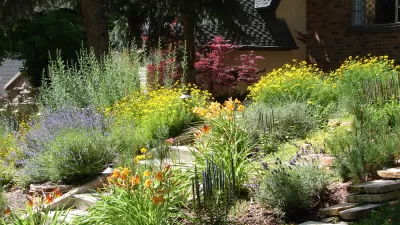The New Yorker traces the history of the American lawn from 1841, commenting on their unnatural origins, and finally analyzing the alternatives suggested by anti-lawn movements.
If one accepts the idea that lawns are, in a deep sense, unethical, how does one fill the front yard?
Over the years, many alternatives to the lawn have been proposed. Pollan, in his book "Second Nature" (1991), suggests replacing parts-or all-of the lawn with garden. In "Noah's Garden" (1993), Sara Stein, by contrast, advocates "ungardening"-essentially allowing the grass to revert to thicket. Sally and Andy Wasowski, in their "Requiem for a Lawnmower" (2004), recommend filling the yard with native trees and wildflowers. For those who don't want to give up the look or the playing space provided by a lawn, the Wasowskis suggest using Buffalo grass, one of the very few turf species native to North America. Smaller American Lawns Today, or SALT, is a concept developed by William Niering, who for many years was a professor of botany at Connecticut College. Niering planted trees around his property, then left most of the rest of his yard unmowed, to become a meadow. "The meadow can take as much of your remaining lawn as you want," he observes in an essay posted on SALT's Web site. "There are some people who prefer no lawn, which is ideal!" For the past few decades, David Benner, a horticulturist from Bucks County, Pennsylvania, has been touting moss as an alternative to grass: he himself has a one-acre "moss garden." Recently, there have been several calls to make the lawnspace productive. In "Food Not Lawns" (2006), Heather C. Flores argues that the average yard could yield several hundred pounds of fruits and vegetables per year. (If you live in an urban area and don't have a lawn, she suggests digging up your driveway.) "Edible Estates" (2008) is the chronicle of a project by Fritz Haeg, an architect and artist, who rips up conventional front yards in order to replace them with visually striking "edible plantings." Haeg calls his approach "full-frontal gardening."
FULL STORY: Turf War

Pennsylvania Mall Conversion Bill Passes House
If passed, the bill would promote the adaptive reuse of defunct commercial buildings.

World's Largest Wildlife Overpass In the Works in Los Angeles County
Caltrans will soon close half of the 101 Freeway in order to continue construction of the Wallis Annenberg Wildlife Crossing near Agoura Hills in Los Angeles County.

U.S. Supreme Court: California's Impact Fees May Violate Takings Clause
A California property owner took El Dorado County to state court after paying a traffic impact fee he felt was exorbitant. He lost in trial court, appellate court, and the California Supreme Court denied review. Then the U.S. Supreme Court acted.

California Grid Runs on 100% Renewable Energy for Over 9 Hours
The state’s energy grid was entirely powered by clean energy for some portion of the day on 37 out of the last 45 days.

New Forecasting Tool Aims to Reduce Heat-Related Deaths
Two federal agencies launched a new, easy-to-use, color-coded heat warning system that combines meteorological and medical risk factors.

AI Traffic Management Comes to Dallas-Fort Worth
Several Texas cities are using an AI-powered platform called NoTraffic to help manage traffic signals to increase safety and improve traffic flow.
City of Costa Mesa
Licking County
Barrett Planning Group LLC
HUD's Office of Policy Development and Research
Mpact Transit + Community
HUD's Office of Policy Development and Research
Tufts University, Department of Urban and Environmental Policy & Planning
City of Universal City TX
ULI Northwest Arkansas
Urban Design for Planners 1: Software Tools
This six-course series explores essential urban design concepts using open source software and equips planners with the tools they need to participate fully in the urban design process.
Planning for Universal Design
Learn the tools for implementing Universal Design in planning regulations.


























